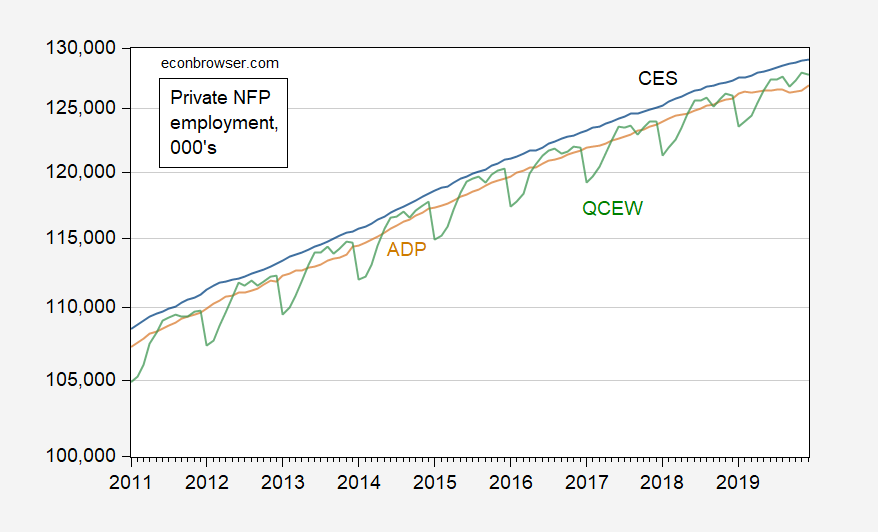I’d say “yes”. From RealClearPolitics:
So, if the BLS job numbers are so unpredictable, and we employ so many people to compile them, why do we pay so much attention to them? The answer is that we are all trying to guess what lies ahead for the economy. Uncertainty is bad for business. But numbers which have to be revised time after time make predictions about the future less certain.
Fortunately, the private sector offers us alternatives. If an independently produced number collected in the private sector—from Automatic Data Processing (ADP) —is as good as the CES, why doesn’t the government just use the ADP data? Payroll providers like ADP offer a robust and more agile alternative for tracking labor market activity. In addition, the correlation between the results released by ADP and the CES are usually positive. Moreover, the ADP data release predates the CES release by two days.
Out of roughly 160M employees in the workforce, ADP manages 30M workers and uses all 30M data points in their release versus a sample of 100,000 or so businesses used by the BLS. Yes, one could argue that we still need the BLS to “sample” the other 80%, but I’m not persuaded that is the case. Our society is very interconnected, and it is entirely reasonable to think that, with some variation, the behavior of 30M actual employees gives us a very good indicator of the overall employment picture.
Thus, data from sources like ADP are effectively rendering the BLS numbers redundant, or at best supplemental. …
Dr. Mateer would do well to learn something about the data series he is discussing. I plot three series on private nonfarm payroll employment: the BLS’s CES, ADP’s, and the Quarterly CENSUS of Employment and Wages.
Figure 1: Private nonfarm payroll employment from CES, s.a. (blue), from ADP, s.a. (tan), and covered private nonfarm payroll employment from QCEW, n.s.a. (green), in 000’s. Source: BLS, ADP via FRED, BLS.
While ADP and CES series comove, they are hardly exactly the same. Dr. Mateer then makes an odd statement:
Consider the stark difference in June 2025, when ADP reported that private employers slashed 33,000 jobs, while the BLS reported an incorrect gain of 147,000 jobs. While methodological differences certainly play a role in such discrepancies…
Well, in point of fact, it’s the coverage that differs which drives the differences. ADP covers firms that use ADP’s services. That means their numbers will not cover large (or other) firms that do not use their services. ADP covers people on the payrolls even if they couldn’t work. BLS counts whether they are working in the reference week. Those are not methodological differences. They’re differences in what’s covered.
Furthermore, the statement that “BLS reported an incorrect gain of 147,000 jobs” is just sloppy reasoning, or at least sloppy language. We don’t know what the actual number is — and if one understood just an eensy, teensy bit of statistics, one would know that since given sampling, we never know the true statistic (we just hope the sample mean converges to the population mean) . Just because the June number was revised doesn’t mean that June number in the current vintage is now the correct one. The June number will again be revised with the August release. It’ll be revised again with the benchmark revisions. So it’s too early to say the 147K gain is “incorrect”.
Dr. Mateer also suggests “Instead of promoting the headline number, the BLS should provide a confidence interval”. That could be done, but in point of fact, BLS provides lots of information regarding standard errors (spreadsheet), also the revision sizes: In other words, BLS procedures are (sometimes mind-numbingly) described. For ADP, some of the compilation is proprietary, and not completely transparent.
FInally, a point that applies generally: private agents have their own agendas for compiling data. ADP has data as a byproduct of its activities. But it doesn’t have as an objective tracking the entire labor market, just the private nonfarm labor market that it services. And, who has an interest in compiling accurately the number of people employed (as opposed to number of jobs). That’s collected by the CPS, but I don’t see who naturally would step into the breach.
Going further afield, who has an interest in collecting NIPA data? I say, eschew the glib claims that “the private sector” can, or will, assemble the requisite data. As a public good, it will generally under-provide.

Mateer also asserts, “Instead of promoting the headline number, the BLS should provide a confidence interval.” Sigh…They do:
https://www.bls.gov/cps/methods/calculating-standard-errors-and-confidence-intervals.pdf
Reading Mateer’s entire text reveals a great deal of motivated logic, bias, supposition and slop. Mateer is providing backup for an article by John Tamny, who’s providing support for E.J. Antoni. It’s echo chamber stuff.
Funny thing is, Mateer takes a paycheck for teaching economics, and is cheerleading for Tamny, who claims economics is a bunch of nonsense. Politics makes strange bedfellows.